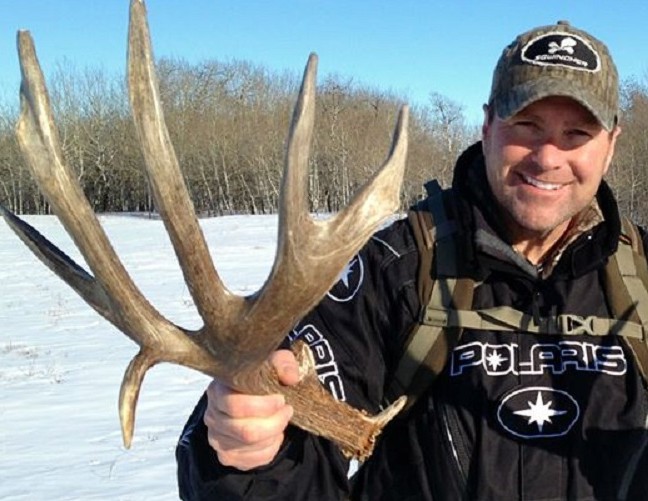Excerpt from Pat & Nicole’s Book: Trophy Whitetails
When I started doing more hunting and getting more interested in learning about whitetails, it was sort of a natural progression to want to find the sheds from some of the bucks I knew about. Before long it became a passion. I began to focus a lot of energy on finding horns; spending lots of time outside walking and looking. Today, in southeast Minnesota where I live, if you don’t find a buck’s sheds right after he drops them, you’re probably not going to own them because someone else is going to pick them up. Today you almost have to catch an antler in midair as it falls off the deer’s head! That’s how competitive it has become!

When Do They Shed?
Our peak shed hunting season in the upper Midwest is from about February 15 to March 15 although the exact time a buck drops his antlers can vary for a variety of reasons. Stress is a major cause of early shedding. Stress from bad weather, a wound, a particularly hard rutting season or even food availability can cause a deer to shed his antlers earlier than normal. Some bucks might be genetically programmed to shed around the first of the year while others may carry their antlers well beyond the normal shedding period. I’ve found fresh sheds as early as mid-December and I’ve seen big bucks that still had both antlers in late March. Specific dates also vary across the country. But if you talk to farmers and landowners or other shed hunters in your area you can easily find out when you need to be in the woods looking for fresh sheds.

Tools
Along with local resources, trail cameras can also tell you when a buck has shed. Several years ago, my good friend Tom Indrebo got some good trail camera photos of a legendary buck we were hunting in Buffalo County, Wisconsin, named Moses. Moses was still carrying his antlers in those photos. The next day, Tom got photos of a bare-headed Moses; he had shed his antlers during the night. Not only did Tom know that Moses had shed, but he also knew approximately where to look for the antlers and he immediately went out and found them.
When to Look
Despite the competition and large number of people out there looking for sheds, sometimes you get lucky. The snow might cover one up after it’s dropped or you stumble across it later on after the snow melts. You might even be in the right place at the right time and find one that has just been dropped. The key is to find them early, especially if you’re looking in the timber or on the edge of the timber – before the squirrels start working on them.

Bucks shed their antlers because of a decrease in testosterone in their body chemistry caused by photoperiod (an increase in the amount of daylight each day). As the days get longer in February and March, the pedicels dry up and the antlers fall off. Amazingly, a number of bucks have been photographed by trail cameras shedding their antlers on the same exact date each year for several years in a row. Whether this is just a coincidence, or whether some type of genetic clock is triggering this, is not known. What is known is that most normal and healthy bucks do shed their antlers about the same date each year, give or take a few days. But each buck is different. While one may shed on or near February 15, another may shed 30 days later on March 15.
Favorite Shed Hunting Conditions
Nicole and I concentrate our efforts to find shed antlers during the 30-day period mentioned above when snow is still on the ground. Some people wait until the snow is gone before they start looking. I love looking in the snow and I’ve found that most antlers contrast with the white snow just enough to stand out really well. When the woods are free of snow, you’re competing with natural ground cover – sticks, branches and leaves that help camouflage the antlers. To me, it’s much more difficult to see them under those circumstances.

If the snow has already melted and I’m hunting for the sheds from a specific buck, I generally try to wait for a damp, rainy day where the woods are wet and dark. Wet antlers have a visible sheen to them and they seem to pop against the forest floor. To me, they’re easier to see under those conditions. Time is always of the essence. Not only are you competing with other shed hunters, but you’re also competing with squirrels and other small rodents that seem to find the antlers as soon as the snow melts. Squirrels can chew up an antler and ruin it very quickly. I always get a big kick out of hunters who show me sheds that have just about been destroyed by squirrels and they’ll think that a mouse did it. It would take an awfully big mouse to devour a large antler. But squirrels are usually the culprits and they can destroy a big antler in a matter of days. Sometimes an antler can lay in the open for years without being bothered by squirrels, but if it’s in woods or close to the tree line, the squirrels will usually find it.







